The Implementation of Bali Local Cultural Values (Jengah, Taksu, and Menyamabraya) in Human Resources Practices Associated with Stress and Organizational Performance in Cooperatives in Bali
on
9 6 Matrik: Jurnal Manajemen, Strategi Bisnis dan Kewirausahaan Vol. 17, No. 1, Februari 2023
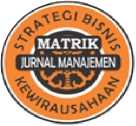
P-ISSN: 1978-2853
E-ISSN: 2302-8890
MATRIK: JURNAL MANAJEMEN, STRATEGI BISNIS DAN KEWIRAUSAHAAN
Homepage: https://ojs.unud.ac.id/index.php/jmbk/index
Vol. 17 No. 1, Februari (2023), 96 - 108
Implementation of Bali Local Cultural Values (Jengah, Taksu, and Menyamabraya) in Human Resources Practices Associated with Stress and Organizational Performance in Cooperatives in Bali
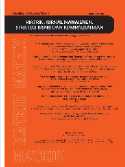

SINTA 2
Ni Wayan Sitiari1) , Luh Kade Datrini2),I Made Suniastha Amerta2), 1,2 ,3Faculty of Economics and Business, University of Warmadewa, Denpasar-Bali.
Email: niwayansitiari2@gmail.com
DOI : https://doi.org/10.24843/MATRIK:JMBK.2023.v17.i01.p08
ABSTRACT
The purpose of this research is to find out and explain the implementation of Balinese cultural values in human resource practices associated with stress and organizational performance. Respondents are managers of cooperatives in Bali total of 79 people. The analysis technique uses the application of a PLS-based structural equation model or SEM (structural equation modeling). The results showed: The influence of HR practices that implement local Balinese cultural is negative and significant on work stress. The influence of the implementation of local cultural values on HR practices on organizational performance is positive and not significant.The effect of stress on organizational performance is increasing. positive and significant. So it is a finding in this study that the implementation of cultural values contained in the concepts of jengah, taksu, and menyamabraya to reduce stress and improve organizational performance. Employees feel no pressure because of the suitability of HR practices with their culture.
Keyword: Cultural Values (Jengah, Taksu, and Meyamabraya) in HR Practices, Stress, Organizational Performance
INTRODUCTION
The development of the business world is inseparable from issues related to globalization and technological developments. Globalization brings competitive changes in organizations business and non-business organizations. The workplace has changed dramatically due to the use of new information and diversity. Organizations in achieving better performance are required to keep up with changes, but on the other hand there are values that must be maintained. It is very difficult to keep up with the changing times without ignoring the noble values prevailing in society. Organizational culture is at least required to follow the values prevailing in society. Organizational culture that is not in accordance with cultural values in society affects employee performance and organizational performance (Olulana, 2015). Organizational performance is the result obtained by an organization, both profit-oriented and non-profit-oriented organizations (Fahmi, 2011).
Theory of action and job performance (Boyatzis, 2008) emphasizes that performance is a combination of the individual and the environment. Knowledge, values, interests that individuals have interacting with culture, structures, systems, strategies, opportunities, and according to roles will shape performance (Salleh, 2010). Based on this theory, the
environment is one of the factors that shape performance. Part of the environment are cultural values in society which then shape the culture of an organization. The prevailing culture in society can be seen as part of the company's resources, which lead to competitive advantage. Like guanxi culture is a culture in China that plays a very important role in Chinese business. Guanxi culture which contains the meaning of brother is not only seen from the existence of blood relations (Wang, 2012), contains almost the same meaning as the menyama braya culture in Bali. Guanxi culture is a social capital that affects business performance (Arribas et al., 2013). The success of the Chinese is supported by the role of guanxi culture which is actualized in business practices. The results of research in several countries show that culture supports organizational performance (Lucky, 2012; Luo, 1997; Wiengarten et al., 2011; Wingarta, 1997; Yiu et al., 2007). While research conducted in Bali has a relationship between Balinese culture and organizational performance. is positive and significant (Riana, 2011; Sitiari et al., 2020; Sugawa, 2014; Suyatna Yasa et al., 2020). Previous researchers in Bali have mostly associated organizational culture with organizational performance.
Research by Sitiari et al. (2016) found that Balinese cultural values that are still maintained and valid and reliable reflecting Balinese culture are the cultural values contained in the concepts of jengah, taksu, and meyamabraya. Jengah is one of the important terms in the Balinese cultural tradition that stimulates the emergence of self-motivation. Without being embarrassed, a person does not have the enthusiasm to work hard to achieve a better life (Dibia, 2013). Taksu will increase confidence and self-confidence because of the strength from within, inner power, which gives intelligence, beauty and as a gift from God as a result of hard work, dedication, submission to certain fields in a pure and disciplined manner (Ardana, 2007). The concept of menyama braya contains togetherness values that are implemented in the form of mutual cooperation, ngayah, nguopin, mutual help, mutual honing, mutual care, paras-paros, saluluk sabayantaka (Meniarta, 2009; Parimartha, 2011). Based on Sitiari et al. (2016), it has been tested that the values in the concepts of jengah, taksu, and meyamabraya are able to improve organizational performance, which have a positive and significant effect on organizational performance. The research of Sitiari et al. (2020) found that organizational culture based on cultural values contained in the concepts of jengah, taksu, and meyamabraya was able to improve organizational performance. This means that an organizational culture that is in accordance with the local culture can improve performance. Ahmad & Schroeder (2003) found that best HR practices should be compatible with the organizational culture, HR practices should also not conflict with cultural values prevailing in society. Employees will feel more comfortable if managed according to their culture. HR practices that implement cultural values in society should be able to improve organizational performance.
Human Resource Management (HRM) is a planned approach to manage people effectively to achieve better performance. It aims to build a management style that is more open, flexible and caring so that employees will be motivated, developed and managed in a way that suits their culture so that they can give their best to achieve better organizational performance. Good HR practices play an important role in helping to achieve the goal of increasing productivity. Carlson et al. (2006) found that HR practice is a very complex decision related to strategy and has a positive effect on organizational performance. Saleem & Khurshidn (2014) also found HR practices, namely withdrawal, and training had a positive and significant effect on organizational performance. Another study Suryani et al. (2018) found HR practices had a positive but not significant effect on fairness and organizational performance. This means that HR practices are not necessarily able to improve fairness and organizational
performance. Sani (2012) also found an insignificant relationship between HR practices and organizational performance.
There are indications that HR practices that are not in accordance with local cultural values are not able to achieve fairness and performance in an organization. To find out whether HR practices that implement local cultural values are able to improve organizational performance, it is necessary to investigate. Dwipayana et al. (2015); Ismail & Gali (2017) found that HR practices related to the performance appraisal system had a negative and significant effect on work stress. This means that the better the HR practice system, especially performance appraisal, the lower employee stress. It can be concluded that in addition to having an impact on organizational performance, HR practices also have an impact on employee stress.
Stress is a concept that describes the relationship between people and the environment. Robbins & Judge (2008)stated that organizational factors can cause stress. Job stress describes stress associated with the professional or work environment. Tension is created when the demands of the job or work environment exceed people's capacity to respond effectively. Work stress is measured by Mas’ud (2004) as follows: excessive workload, difficulty communicating with other parties, unclear job responsibilities, unable to do daily work, difficulty in maintaining relationships, role in the organization interfering in family life, carry out a role that is contrary to conscience. Based on the results of the study found that stress has a negative and significant effect on employee performance (Sitiari et al., 2020). However, there are also other studies that stress has a positive effect on employee performance (Yoga,
Based on the results of previous studies, organizational performance is determined by HR practices (Roca et al., 2006; Saleem & Khurshidn, 2014; Sani, 2012). However, other studies have found that the influence of HR practices on fairness and organizational performance is positive and insignificant (Suryani et al., 2018). The insignificant relationship indicates that HR practices are not in accordance with the cultural values prevailing in society, so that employees feel they are not being treated fairly so that there is a tendency for employees to become depressed or stressed. It turns out that HR practices also have an impact on stress (Dwipayana et al., 2015; Ismail & Gali, 2017). There are indications that an insignificant relationship can be caused by a mismatch with values in HR practices with individual values.
Problems related to organizational performance are very relevant to be studied in cooperatives in Bali. Cooperatives are organizations that are very close to the community. Based on the results of Sitiari et al. (2016), the results of interviews with 95 cooperative managers in Bali show that the performance of cooperatives in Bali in terms of financial aspects tends to be the lowest compared to other aspects, while the number of cooperatives is growing very rapidly. The development of cooperatives in Badung Regency, one of the regencies in Bali from 2019 has 567 active cooperative units and 68 inactive units. The existence of inactive cooperatives shows that cooperative performance still needs to be improved. Based on the results of previous research, it is necessary to examine how the implementation of local Balinese cultural values contained in the concepts of jengah, taksu, and meyamabraya in HR practices is associated with stress and organizational performance.
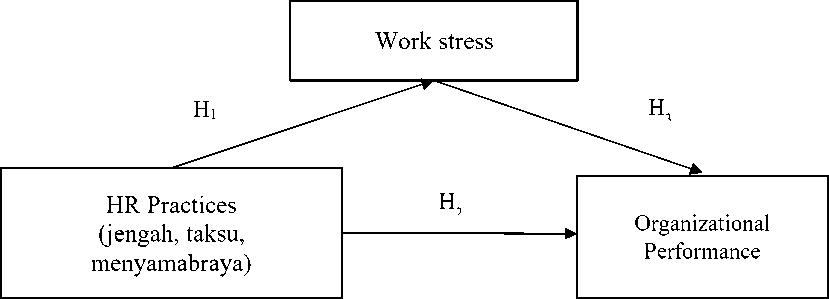
Figure 1: Research Concept Framework
Source: Previous Research Studies
Based on the conceptual framework and research objectives of this research hypothesis:
-
H1: The effect of HR practices based on local cultural values on work stress is negative and significant.
-
H2: The effect of HR practices based on local cultural values on organizational performance is positive and significant
-
H3: The effect of work stress on organizational performance is negative and significant.
METHODS
The research location is savings and loan cooperatives in Badung Regency and Denpasar City with cooperative managers as respondents. While the object of research is HR practices based on local Balinese cultural values, work stress, and organizational performance. Research respondents are managers of cooperatives located in Badung district and Denpasar city. Regency with the highest number of cooperatives in Bali. The number of respondents was 79 managers, who met the requirements were analyzed using the Smart PLS analysis tool. The research design used a quantitative model (Creswell, 2010), and analyzed multivariately with the application of a PLS-based structural equation modeling model (SEM).
Collecting data using a questionnaire consisting of 34 statements that have been prepared related to research variables. The variables identified to measure the research are: 1) Exogenous variables (exogenous variables) variables of HR practices based on cultural values that refer to Sitiari et al. (2016); Suryani et al. (2018), with the following indicators: X1. Selection and recruitment are carried out based on skills to increase willingness or high enthusiasm to compete in a healthy manner (reflecting jengah values). X2. Providing orientation for new employees motivates them to excel (reflects jengah values)).X3. Provide internal opportunities before opening new vacancies to increase enthusiasm to work hard in order to achieve a better life (reflecting jengah values), X4. Using the principle of honesty in determining every decision in the selection and recruitment process (reflecting taksu values) X5. In the selection and recruitment process, we prioritize brotherly relations with mutual respect, establish good cooperation, and make decisions based on mutual agreement (reflecting the values of menyama braya), X6. Providing training programs for all employees to increase employee's ability and confidence (reflecting taksu values). Confidence in carrying out his profession (reflecting taksu values).) X7. Regular training schedule to provide enthusiasm for learning (reflecting jengah values), X8. Providing training according to employee needs so that the ability to produce something interesting for others (reflecting taksu values), X9.
Performance appraisal is carried out objectively by using the principle of honesty in determining every decision (reflecting taksu values).) ,X9. Performance appraisal helps employees in career development, namely to establish cooperation both for the common good and for the benefit of the individual (menyamabraya ), X10. Salary increase based on performance results to increase competitive spirit (reflecting jengah values).X11. Giving higher salaries to employees who excel increases achievement motivation (reflects jengah values).X12. X13. Awards for employees who achieve the target of enthusiasm to work hard (reflecting jengah values). X14. Provide opportunities to discuss careers prioritizing brotherly relationships, mutual respect, and mutual help and tolerance (reflecting the values of menyamabraya), X15. Career development programs are structured and clear because they feel they need each other (reflects the value of menyamabraya)
Work stress variable is measured by indicators referring to Mas’ud (2004) as follows: Y1.1. excessive workload, Y1.2. difficulty communicating with other parties, Y1.3. unclear job responsibilities, Y1.4. unable to do daily work, y.15. difficulty in maintaining relationships, Y.1.6 role in the organization interfering with family life, Y1.7 carrying out roles that are contrary to conscience. The endogenous variable, namely organizational performance using the Balanced Score Card (BSC) theory, is a performance framework and was developed by Robert Kaplan and David Norton in 1992 (Fahmi, 2011). BSC emphasizes four studies, namely financial, customer, internal business, learning and growth perspectives with the following indicators: The aspects used in measuring organizational performance include: Organizational performance from a financial perspective (aspects of increasingly healthy performance). Measured by indicators, namely: Y2.1 Ability to provide funds, Y2.2 Sales growth, growth in SHU, Y2.3 Asset growth, and increased business volume. Organizational performance from the customer perspective (aspects of service to members and the community). Measured by indicators, namely: Y2.4 Transactions with members, Y2.5 Education and training for members, Y2.6 Ability to absorb labor, Y2.7 Number of services cooperatives to the general public. Organizational performance from the perspective of internal business processes (aspects of active business entities). Measured by indicators, namely: Y.2.8 Annual Member Meeting, Y2.9 Management process of running business activities and compliance with regulations. Organizational performance from the perspective of learning and growth (aspects of cohesiveness and Y3.10 Member participation and aspects of contribution to regional development). Organizational performance from a learning perspective is measured by the following indicators: Y2.11 Members tend to pay off mandatory savings and attend member meetings. Y2.12. Cooperatives tend to be obedient in paying taxes
The results of the instrument validity test illustrate that all indicators forming the variables (X, Y1 and Y2) are considered valid as research test tools because they produce a Pearson correlation coefficient (r) > 0.30 , n = 30, at level 0.1 (Sugiyono, 2017). The lowest correlation coefficient (r) for; HR practices is X15 with a value of 0.429. and the highest is X14, with 0.753. As for stress, the highest is X18 with a value of 0.919, and the lowest is X16 with a value of 0.505. For performance variables, organizational performance variables are: the indicator with the highest coefficient value is Y2.24, namely Y2.24 with a value of 0.813 and the lowest is Y2.23 with a value of 0.451. Instrument reliability test is measured by Cronbach's Alpha (á) formula and a variable is said to be reliable if it produces a value of á > 0, 60 (I. Ghozali, 2016). The results of the reliability test illustrate that all indicators forming the variables (X, Y1 and Y2) in the study show the value of Cronbach's Alpha (á) > 0.60 (X = 0.83, Y1 = 0.907, and Y2 = 0.830) at n = 30. This means that the variables in the questionnaire are conside ed valid and eliable as a esea ch test tool.
RESULT AND DISCUSSION
The results of respondents' answers based on the questionnaire showed that the variable of HR practices based on cultural values was in the high category with an answer score of 4.01, for the stress variable was low with an average score of 2.5, while for organizational performance it was high with an average score of 2.5. 3.67 average. Profile of Respondents Cooperative Manager The dominant respondent is over 45 years old, namely 53%, while the education level shows the education level of the dominant respondent with undergraduate education, namely 57 people or 76%.
This study uses research variables consisting of indicators that make up reflective variables. To test the validity and reliability of the indicators that make up the variables evaluated from the coefficients of convergent validity, discriminant validity, composite reliability, and Cronbach alpha. Convergent validity is measured based on the outer loading test criteria for each indicator. Outer loading values ranging from 0.50-0.60 were declared valid and significant, and indicators with values below 0.50 were excluded from the model.
Convergent validitymeasured based on the outer loading test criteria for each indicator. Outer louding test results Outer loading are presented in Table 2.
Table 2. Outer loading research variables
|
Performance_Organization |
_HR Practice |
_Work Stress |
information | |
|
X1.1 |
0.665 |
valid | ||
|
X1.11 |
0.617 |
valid | ||
|
X1.12 |
0.756 |
valid | ||
|
X1.13 |
0.660 |
valid | ||
|
X1.2 |
0.528 |
valid | ||
|
X1.4 |
0.652 |
valid | ||
|
X1.6 |
0.709 |
valid | ||
|
X1.8 |
0.576 |
valid | ||
|
Y1.17 |
0.600 |
valid | ||
|
Y1.18 |
0.757 |
valid | ||
|
Y1.19 |
0.849 |
valid | ||
|
Y1.20 |
0.911 |
valid | ||
|
Y1.21 |
0.771 |
valid | ||
|
Y1.22 |
0.827 |
valid | ||
|
Y2.23 |
0.819 |
valid | ||
|
Y2.24 |
0.843 |
valid | ||
|
Y2.25 |
0.723 |
valid |
Source: Processed data, 2021.
A good discriminant validity is that the square root of AVE for each construct is greater than 0.50. The AVE root value for each dimension ranges from 0.50-0.70 indicating the discriminant test results according to the required AVE value is greater than 0.50 (Imam Ghozali & Latan, 2012). A measurement can be said to be reliable, if the composite reliability and Cronbach alpha have a value greater than 0.70. The composite reliability and Cronbach alpha values meet the reliable criteria, with each value > 0.70, which shows that all indicators that make up the construct are valid and reliable. The values of AVE, composite reliability, and cronbach's alpha are presented in the table. 3.
Table 3. Construct Reliability and Validity
|
Cronbach's Alpha |
rho_A |
Composite Reliability |
Average Variance Extracted (AVE) | |
|
Performance_Organization |
0.727 |
0.769 |
0.839 |
0.635 |
|
_HR Practice |
0.803 |
0.808 |
0.852 |
0.530 |
|
_Work Stress |
0.877 |
0.888 |
0.909 |
0.627 |
Source: Processed data, 2021.
The value of R Square indicates that each latent variable is endogenous as the predictive power of the structural model. Changes in the value of R Square can be used to explain the effect of certain exogenous latent variables on endogenous latent variables that have a substantive effect. R Square value of 0.75 concluded that the model is strong, 0.50 moderate, and 0.25 weak (Imam Ghozali & Latan, 2012). R Square value of each variable above 0.50 indicates a strong model. Organizational performance variable with R2 value 0.97 and work stress 0.689. Based on the R2 value, the model is classified as strong. R2 value of each variable is presented in Table 4.
Table 4. Value of R 2 Variable
|
R Square |
Information | |
|
Performance_Organization |
0.971 |
strong |
|
_Work Stress |
0.689 |
strong |
Source: Processed data, 2021.
Evaluation of structural models through Q-Square Predictive Relevance (Q2)
Q-Square Predictive Relevance (Q2)is a measure of how well the observations made give results to the research model. The value of Q-Square Predictive Relevance (Q2) ranges from 0 (zero) to 1 (one). Q2 = 1- (1- R12) ( 1- R22 ) …..( 1- Rn2)
Q2= 1-( 1- 0.9712) (1- 0.6892)
Q2 = 1- (1- 0.942) ( 1- 474)
Q2 = 1- ( 0.058) ( 0.525)
Q2 = 0.96 (strong model).
The results of hypothesis testing the relationship between variables are presented in Table 5. The effect of HR practices based on local Balinese cultural values (jengah, taksu, and meyamabraya) on work stress is negative and significant. the value of v value is 0.000, with a statistical t test value of 7.906 which is greater than the t table of 1.96. This means that the stronger the implementation of cultural values of shy, taksu, and menyama braya in HR practices, the lower employee stress. Based on the results of the analysis, it is shown that HR practices based on local cultural values (jengah, taksu, and meyamabraya) on organizational performance are positive and not significant. With a coefficient value of 0.303, V value is greater than 0.05 and the statistical test is smaller than the value of 1.96. This means that the better the implementation of cultural values in HR practices, the organizational performance will increase but not significantly. The effect of stress on organizational performance is positive and significant with a coefficient value of 0.018, which is smaller than 0.05 with a T statistic of 2.381 greater than 1.96. This means that the higher the stress the higher the organizational performance and significant.
Table 5. The results of the analysis of the relationship between variables
|
Original Sample Sample Mean (O) (M) |
Standard T Statistics P (DSeTvDiaEtiVon) (|O/STDEV|) Values information |
|
_HR Practice -> 0.206 0.186 Organization_Performance _HR Practice -> _Work -0.538 -0.564 Stress _Work Stress -> 0.358 0.348 Performance_Organization |
0.208 0.993 0.321 Not significant 0.068 7,906 0.000 significant 0.151 2,381 0.018 significant |
Source: Processed data, 2021.
Theresults ofstatistical tests canalso bepresentedin the following figure:
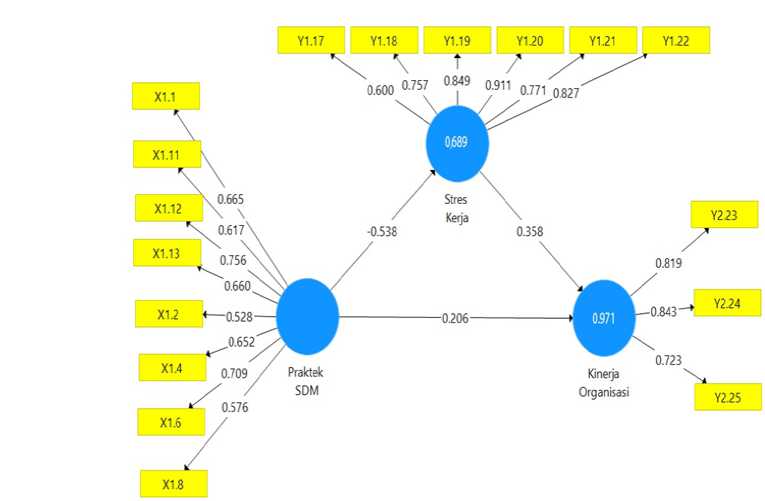
Figure 2. Full Model
Source: Processed data, 2021.
The influence of HR practices that implement local Balinese cultural values (jengah, taksu, and meyamabraya) is negative and significant on work stress. This means that the stronger the implementation of cultural values of jengah, taksu, and menyama braya in HR practices, the stress employees are getting lower. The implementation of the cultural values of jengah taksu and meyamabraya is reflected in the indicators of HR practices as follows: X1.1 The implementation of selection and recruitment is carried out based on skills to increase willingness or high enthusiasm to compete in a healthy manner, high willingness and enthusiasm to compete contains elements menyamabraya culture. X.2. Providing orientation for new employees motivates them to excel, motivation to achieve reflects a culture of jengah, X.1. 4, namely using the principle of honesty in determining every decision in the selection and recruitment process, prioritizing the principle of honesty reflecting the values contained in the taksu concept. Salary increase based on performance results to increase competitive
spirit, competitive spirit reflects a culture of jengah, Giving higher salaries to employees who excel increases achievement motivation. Awards for employees who achieve the target of enthusiasm to work hard. The provision of training programs for all employees to improve the ability and self-confidence of employees, reflects the concept of taksu. Confident in carrying out his profession, Providing training in accordance with the needs of employees so that the ability to produce something interesting for others reflects the concept of taksu. Based on the results of the analysis, it is shown that HR practices in cooperatives in Bali already reflect the values contained in the concepts of jengah, and taksu. The concept of menyamabraya based on respondents' answers has been applied to the performance appraisal process, including performance appraisal, reflected in the indicators of helping employees in career development, namely because of mutual need between managers and employees. Career development is reflected in clear structural indicators in career development because they feel they need each other. While the second indicator is to provide opportunities to discuss careers that prioritize brotherhood, mutual respect, and mutual help and tolerance. In the selection and recruitment process, we prioritize brotherly relations with mutual respect, Establish good cooperation, and make decisions based on mutual agreement. The concept of meyamabraya has been reflected in the process of establishing a cooperative, such as choosing members, preferably from members in the family, one office, or association. The results of this study support the results of previous studies: Arribas et al. (2013); Dwipayana et al. (2015); Ismail & Gali (2017); Sitiari et al. (2016); Suyatna Yasa et al. (2020). This study discusses how the role of culture implemented in organizational culture can reduce employee stress. The results of this study prove that HR practices such as providing compensation, selection, development, and performance appraisal by implementing cultural values where they live in society can reduce stress, because employees feel the suitability of individual behavior with the organization where they work. This approach is very suitable for retaining employees to achieve better organizational performance.
Based on the results of the analysis, it is shown that HR practices based on local cultural values (jengah, taksu, and meyamabraya) on organizational performance are positive and not significant. This means that the better the implementation of cultural values in HR practices, the organizational performance will increase but not significantly. HR practices that implement the cultural values contained in the concepts of jengah, taksu, and menyama braya have not necessarily been able to improve organizational performance. Although HR practices have not been able to significantly improve performance, this study proved that the implementation of cultural values in HR practices was able to reduce employee stress. The insignificant relationship can be caused that based on the fact that respondents' answers to the implementation of cultural values in HR practices are not yet very strong, and the tenure of the respondents is only 6% above 5 years, meaning that the tenure of service under 5 years tends not to have a very strong culture. strong in implementing cultural values in HR practices. This research supports previous researches Roca et al. (2006); Saleem & Khurshidn (2014); Sani (2012); Sitiari et al. (2016, 2020); Suryani (2017); Suyatna Yasa et al. (2020).
The effect of stress on organizational performance is positive and significant. This means that the higher the stress, the higher the organizational performance and significant. This relationship is in accordance with the theory of the human performance curve adapted from Hm Muhdar (2012). In the early stages along with increasing stress, human performance also increases at a certain point. At that stage humans do not consider themselves stressed, but in a state of stress. excited, passionate or full of encouragement. But past that point the
additional stress will make performance decline. Human performance can be described in the fom of a cuve:
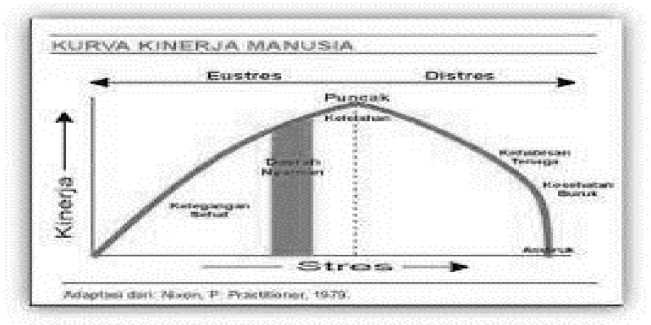
Figure 3. Performance Curve
Source: Muhdar, 2012
Related to the results of this study, which found that stress had a positive effect on performance, it could be due to conformity with individual values derived from values in society. Employees will not feel stress so that it can improve organizational performance. The results of this study do not support previous research that stress has a negative effect on performance (Sitiari et al., 2020). In this case, it can be caused by the background of cultural values, the individual will feel motivated and not feel any pressure. A person will feel an optimal stress range or comfort zone area that makes him feel comfortable and can perform well.
CONCLUSION
The influence of HR practices that implement local Balinese cultural values (jengah, taksu, and meyamabraya) is negative and significant on work stress. This means that the stronger the implementation of cultural values of jengah, taksu, and menyamabraya in HR practices, the stress employees are getting lower. HR practices based on local cultural values (jengah, taksu, and meyamabraya) on organizational performance are positive and not significant. This means that the better the implementation of cultural values in HR practices, the organizational performance will increase but not significantly. HR practices that implement the cultural values contained in the concepts of jengah, taksu, and menyama braya have not necessarily been able to improve organizational performance. The effect of stress on organizational performance is positive and significant. This means that the higher the stress the higher the organizational performance and significant. A positive relationship can be caused that stress is also needed in improving performance.
Based on the results of this study, suggestions for managers of cooperatives in Bali should be managed according to the cultural values that exist in the community. Cooperatives are organizations that are very close to the community because they are one of the people's choices in driving the economy in Bali.
Subsequent research to add other variables such as the strategy variable because the insignificant relationship between HR practices and organizational performance may be mediated by the strategy variable.
REFERENCES
Ahmad, S., & Schroeder, R. G. (2003). The impact of human resource management practices on operational performance: Recognizing country and industry differences. Journal of Operations Management, 21(1), 19–43. https://doi.org/10.1016/S0272-6963(02)00056-6
Ardana, I. G. G. (2007). Empowering Balinese Local Wisdom in Facing Global Culture. Pustaka Tarukan Agung.
Arribas, I., Hernández, P., & Vila, J. E. (2013). Guanxi, performance and innovation in entrepreneurial service projects. Management Decision, 51(1), 173–183.
https://doi.org/10.1108/00251741311291373
Boyatzis, R. E. (2008). Competencies in the 21st century. Journal of Management Development, 27(1), 5–12. https://doi.org/10.1108/02621710810840730
Carlson, D. S., Upton, N., & Seaman, S. (2006). The impact of human resource practices and compensation design on performance: An analysis of family-owned SMEs. Journal of Small Business Management, 44(4), 531–543. https://doi.org/10.1111/j.1540-627X.2006.00188.x
Creswell, J. W. (2010). Research Design Pendekatan Kualitatif, Kuantitatif, dan Mixed. Pustaka Belajar.
Dibia, I. W. (2013). Mempertahankan Taksu Bali di Era Globalisasi. Hindu Media.
Dwipayana, A. D., Supartha, W. G., & Sintaasih, D. K. (2015). Penerapan Sistem Penilaian: Dampaknya Terhadap Kepuasaaan Dan Stress Kerja Karyawan. E-Jurnal Ekonomi Dan Bisnis, 4(10), 643–664.
Fahmi, I. (2011). Manajemen Kinerja: Teori dan Aplikasi. Bandung: Alfabeta.
Ghozali, I. (2016). Aplikasi Analisis Multivariate dengan Program IBM SPSS 21 -.Update PLS Regresi. Universitas Diponegoro.
Ghozali, Imam, & Latan, H. (2012). Partial Least Squares,Konsep, Teknik, dan Aplikasi Menggunakan Program SmartPLS 3.2.9 Untuk Peneliti. Diponogoro University Semarang Publisher.
Hm Muhdar. (2012). Stres Kerja Dan Kinerja Dalam Perspektif Teori Dan Bukti Empirik. Jurnal Ekonomika Bisnis, 03(02). https://doi.org/10.22219/jekobisnis.v3i2.2234
Ismail, H. N., & Gali, N. (2017). Relationships among performance appraisal satisfaction, work-family conflict and job stress. Journal of Management and Organization, 23(3), 350–372. https://doi.org/10.1017/jmo.2016.15
Lucky, E. O. (2012). The joint moderating effect of location and culture on smal firm
performance. International Journal of Academic Research in Business and Social Sciences, 2(1), 324–340.
Luo, Y. (1997). Guanxi and Performance of Foreign-Invested Enterprises in China: An Empirical Inquiry. MIR: Management International Review, 37(1), 51–70.
Mas’ud, F. (2004). Survai Diagnosis Organisasional. Universitas Diponegoro.
Meniarta, I. K. (2009). Dinamika Sistem Kesejahteraan dan Modal Sosial di Masyarakat Banjar Pakraman-Bali. Jurnal Ilmu Sosial Dan Politik, 13(November), 231–248. https://jurnal.ugm.ac.id/jsp/article/view/10963
Olulana, B. S. (2015). The correlates of organisational culture, job stress and organisational commitment. Asian Journal of Business and Management, 03(02).
Parimartha, I. G. (2011). Nilai Karakter Bangsa dan Aktualisasinya Dalam Kehidupan Masyarakat Bali. Udayana University Press.
Riana, I. G. (2011). Dampak Penerapan Kultur Lokal Tri Hita Karana terhadap Orientasi Kewirausahaan dan Orientasi Pasar. Jurnal Teknik Industri, 13(1).
https://doi.org/10.9744/jti.13.1.37-44
Robbins, S. P., & Judge, T. A. (2008). Perilaku Organisasi Edisi ke-12. Salemba Empat. https://doi.org/10.24843/jiab.2019.v14.i01.p11
Roca, J. C., Chiu, C. M., & Martínez, F. J. (2006). Understanding e-learning continuance intention: An extension of the Technology Acceptance Model. International Journal of Human Computer Studies. https://doi.org/10.1016/j.ijhcs.2006.01.003
Saleem, I., & Khurshidn, A. (2014). Do Human Resource Practices affect Employee Performance? Pakistan Business Review, 15(4), 669–688.
http://www.iobm.edu.pk/PBR/PBR_1401_V15N4/PBR_V15N4.pdf
Salleh, K. M. (2010). Globalization ’ s Impact on Soft Skills Demand in the Malaysian Workforce and Organizations : What makes graduates employable ? Proceedings of the 1stUPI International Conference on Technical and Vocational Education and Training, November, 10–11.
Sani, A. D. (2012). Strategic Human Resource Management And Organizational Performance In The Nigerian Insurance Industry: The Impact Of Organizational Climate. Business Intelligence Journal January, 5(1).
Sitiari, N. W., Puspaningsih, N. L. A., & Dharmenegara, I. B. A. (2020). Local Values-Based Organizational Culture : a Study of Balinese Cultural Values Effects on Cooper- Atives Employee Performance and Job Stress in Bali. PalArch’s Journal of Archaeology of Egypt, 17(4), 3209–3222.
Sitiari, N. W., Suprapti, N. W. S., Sintaasih, D. K., & Sudibya, I. G. A. (2016). Exploration of Bali’s Cultural Values and Entrepreneurial Orientation in Relation to Cooperative Managers In Bali. European Journal of Business and Managemen, 8(4), 158–169.
Sugawa, I. N. K. (2014). The Influence of Organizational Culture (Catur Purusa Artha) on Entrepreneurship Orientation and Organizational Performance. University of Brawijaya
Malang.
Sugiyono. (2017). Metode Penelitian Pendidikan (Pendekatan Kuantitatif, Kualitatif dan R&D). Alfabeta.
Suryani. (2017). Faktor Keuangan dan Non-Keuangan sebagai Determinan Nilai Perusahaan dengan Good Corporate Governance sebagai Variabel Pemoderasi. Jurnal Akuntansi Dan Keuangan.
Suryani, N. K., Yoga, G. A. D. M., & Sugianingrat, I. A. P. W. (2018). Impact Of Human Resources Management Practice On Employee Satisfaction And Customer Satisfaction (case study SMEs in Bali, Indonesia). International Journal of Sustainability, Education, and Global Creative Economic (Ijsegce), 1(1), 59–62.
Suyatna Yasa, P. N., Sitiari, N. W., & Kreswanto, I. (2020). The Effect of Entrepreneurship Orientation and Organizational Culture on Funding Decisions and Organizational Performance on Spa Product Smes in Bali Province. Talent Development & Excellence, 12(1).
Wang, R. (2012). Chinese Culture and Its Potential Influence on Entrepreneurship. International Business Research, 5(10), 76–90. https://doi.org/10.5539/ibr.v5n10p76
Wiengarten, F., Fynes, B., Pagell, M., & de Búrca, S. (2011). Exploring the impact of national culture on investments in manufacturing practices and performance: An empirical multicountry study. International Journal of Operations and Production Management, 31(5), 554–578. https://doi.org/10.1108/01443571111126328
Wingarta. (1997). Jengah and it’s Value Transformation: Center For Religious and Cross Cultural Studies. Gajah Mada University, Yogyakarta (dissertation).
Yiu, E., Lee, C., & Anderson, A. R. (2007). The Role Of Guanxi In Chinese Entrepreneurship.
Journal of Asia Entrepreneurship and Sustainability, III(3), 2–18.
Discussion and feedback